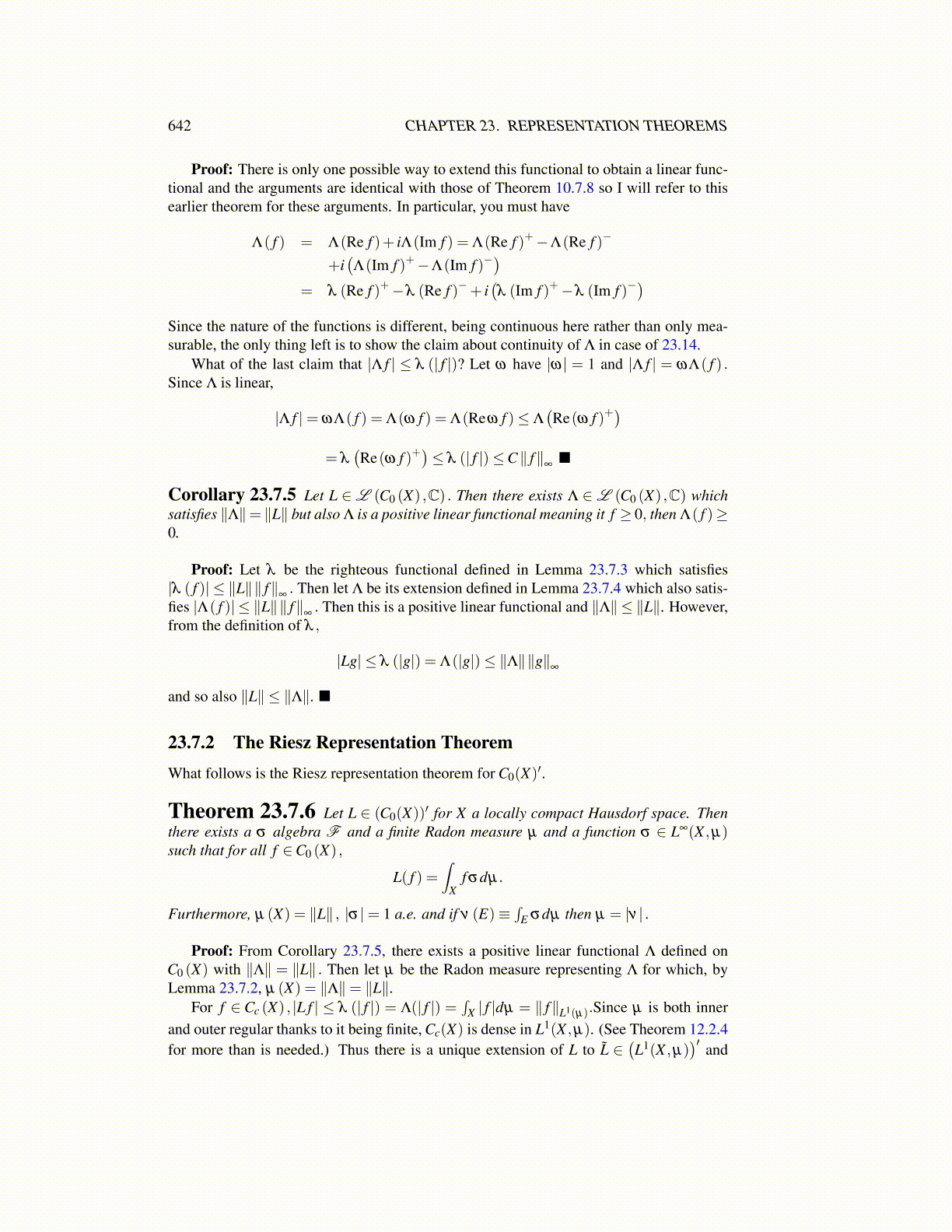
642 CHAPTER 23. REPRESENTATION THEOREMS
Proof: There is only one possible way to extend this functional to obtain a linear func-tional and the arguments are identical with those of Theorem 10.7.8 so I will refer to thisearlier theorem for these arguments. In particular, you must have
Λ( f ) = Λ(Re f )+ iΛ(Im f ) = Λ(Re f )+−Λ(Re f )−
+i(Λ(Im f )+−Λ(Im f )−
)= λ (Re f )+−λ (Re f )−+ i
(λ (Im f )+−λ (Im f )−
)Since the nature of the functions is different, being continuous here rather than only mea-surable, the only thing left is to show the claim about continuity of Λ in case of 23.14.
What of the last claim that |Λ f | ≤ λ (| f |)? Let ω have |ω| = 1 and |Λ f | = ωΛ( f ) .Since Λ is linear,
|Λ f |= ωΛ( f ) = Λ(ω f ) = Λ(Reω f )≤ Λ(Re(ω f )+
)= λ
(Re(ω f )+
)≤ λ (| f |)≤C∥ f∥
∞■
Corollary 23.7.5 Let L ∈L (C0 (X) ,C) . Then there exists Λ ∈L (C0 (X) ,C) whichsatisfies ∥Λ∥= ∥L∥ but also Λ is a positive linear functional meaning it f ≥ 0, then Λ( f )≥0.
Proof: Let λ be the righteous functional defined in Lemma 23.7.3 which satisfies|λ ( f )| ≤ ∥L∥∥ f∥
∞. Then let Λ be its extension defined in Lemma 23.7.4 which also satis-
fies |Λ( f )| ≤ ∥L∥∥ f∥∞. Then this is a positive linear functional and ∥Λ∥ ≤ ∥L∥. However,
from the definition of λ ,
|Lg| ≤ λ (|g|) = Λ(|g|)≤ ∥Λ∥∥g∥∞
and so also ∥L∥ ≤ ∥Λ∥. ■
23.7.2 The Riesz Representation TheoremWhat follows is the Riesz representation theorem for C0(X)′.
Theorem 23.7.6 Let L ∈ (C0(X))′ for X a locally compact Hausdorf space. Thenthere exists a σ algebra F and a finite Radon measure µ and a function σ ∈ L∞(X ,µ)such that for all f ∈C0 (X) ,
L( f ) =∫
Xf σdµ.
Furthermore, µ (X) = ∥L∥ , |σ |= 1 a.e. and if ν (E)≡∫
E σdµ then µ = |ν | .
Proof: From Corollary 23.7.5, there exists a positive linear functional Λ defined onC0 (X) with ∥Λ∥ = ∥L∥ . Then let µ be the Radon measure representing Λ for which, byLemma 23.7.2, µ (X) = ∥Λ∥= ∥L∥.
For f ∈ Cc (X) , |L f | ≤ λ (| f |) = Λ(| f |) =∫
X | f |dµ = ∥ f∥L1(µ).Since µ is both innerand outer regular thanks to it being finite, Cc(X) is dense in L1(X ,µ). (See Theorem 12.2.4for more than is needed.) Thus there is a unique extension of L to L̃ ∈
(L1(X ,µ)
)′ and